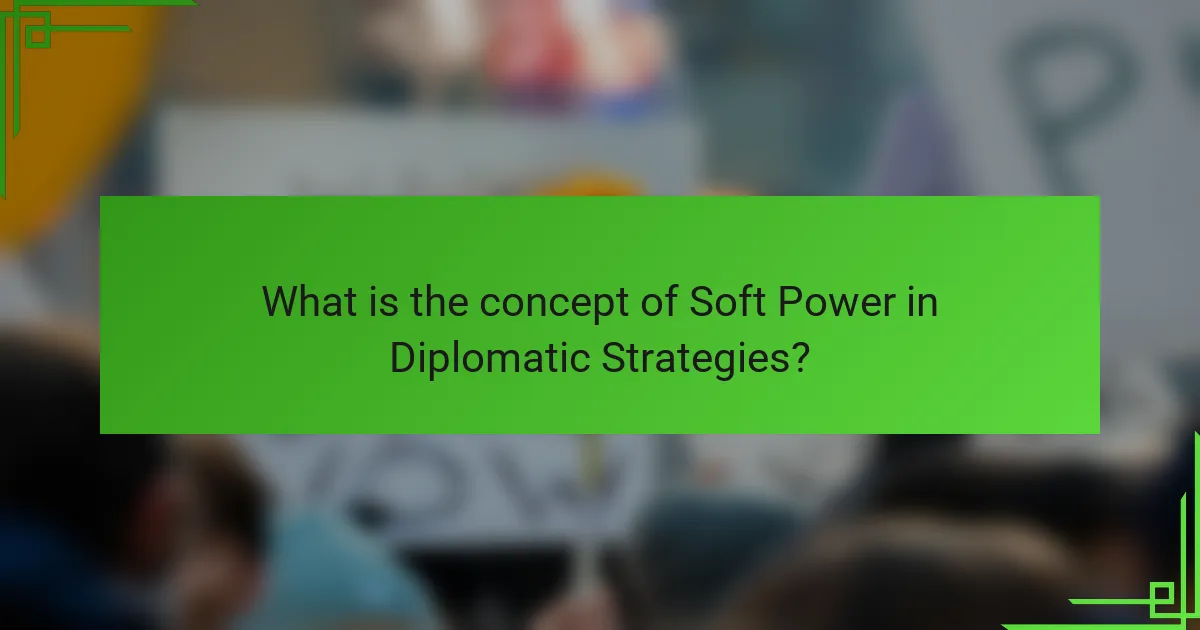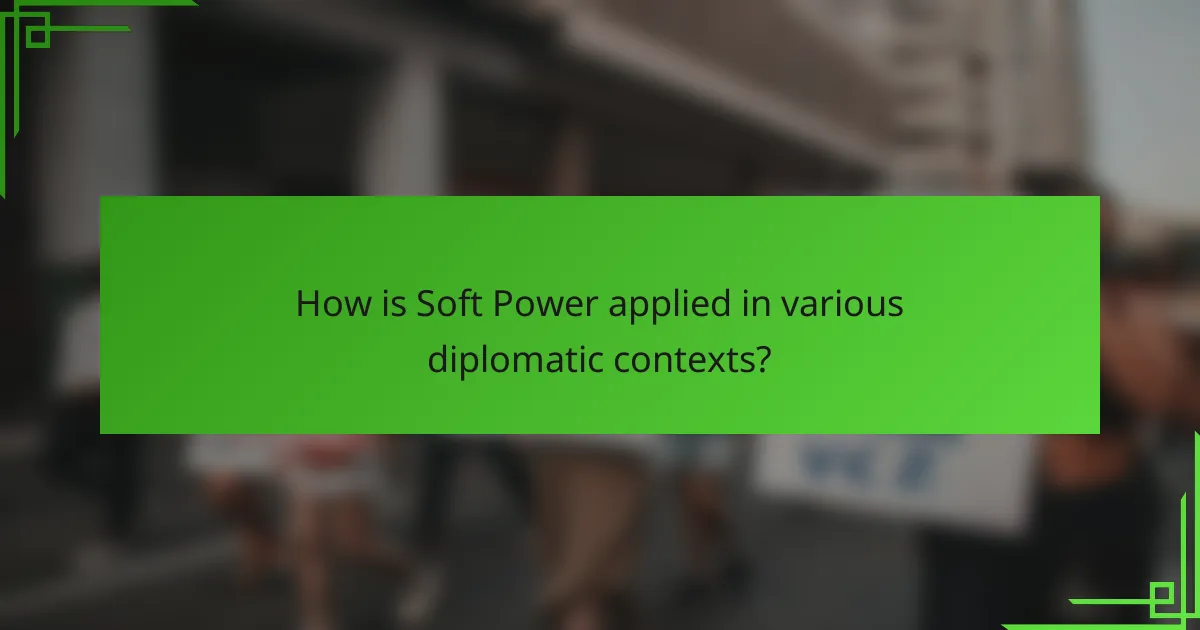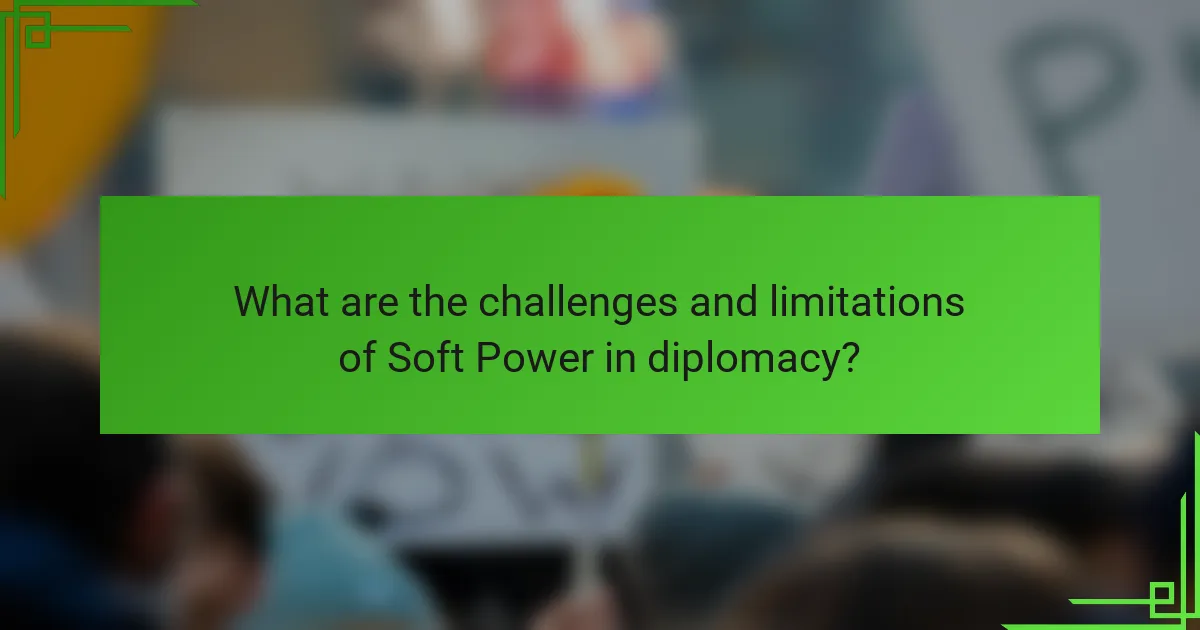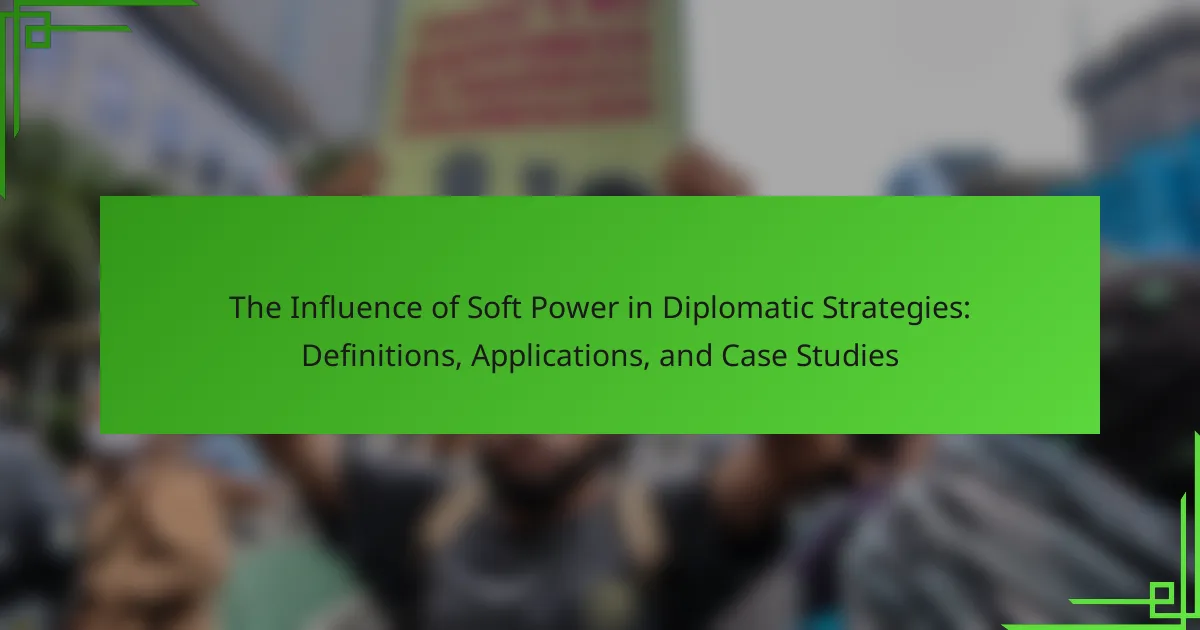Soft power is defined as the ability of a country to influence others through attraction rather than coercion, relying on cultural appeal, values, and policies perceived as legitimate. This article explores the concept of soft power in diplomatic strategies, detailing its applications, including cultural exchange, international aid, and public diplomacy. It highlights the effectiveness of soft power, exemplified by the United States’ use of cultural exports to enhance its global image. Additionally, the article addresses the challenges and limitations of soft power, such as measurement difficulties, potential misinterpretations, and the impact of a nation’s credibility on its soft power initiatives.

What is the concept of Soft Power in Diplomatic Strategies?
Soft power is the ability of a country to influence others through attraction rather than coercion. It relies on cultural appeal, values, and policies that are seen as legitimate or moral. This concept contrasts with hard power, which uses military and economic means to achieve foreign policy goals. Soft power can enhance a nation’s global standing and foster cooperation. Key elements include diplomacy, cultural exchange, and international aid. For example, the United States has historically used its cultural exports, like movies and music, to build a favorable image abroad. According to Joseph Nye, who coined the term, soft power is essential for effective diplomacy in a globalized world.
How does Soft Power differ from Hard Power in diplomacy?
Soft power differs from hard power in that it relies on attraction and persuasion rather than coercion or force. Soft power uses cultural influence, values, and diplomacy to shape preferences. In contrast, hard power employs military and economic means to achieve objectives. For example, the United States has used soft power through cultural exports like Hollywood films. Conversely, it has also applied hard power through military interventions. Research by Joseph Nye highlights these distinctions in his works on power dynamics. Nye’s framework illustrates how soft power can enhance a nation’s global standing without the use of force.
What are the key characteristics of Soft Power?
Soft power is the ability to influence others through attraction and persuasion rather than coercion. Key characteristics of soft power include cultural appeal, political values, and foreign policies that are seen as legitimate. Cultural appeal allows nations to promote their culture, values, and ideologies globally. Political values refer to the principles of democracy and human rights that resonate with other nations. Legitimate foreign policies build trust and cooperation, enhancing a nation’s global image. Soft power relies on non-material resources, such as diplomacy and international cooperation. It contrasts with hard power, which uses military force or economic sanctions. These characteristics enable countries to achieve strategic goals without resorting to force.
Why is Soft Power increasingly important in modern diplomacy?
Soft power is increasingly important in modern diplomacy because it enables countries to influence others through attraction rather than coercion. This approach fosters positive relationships and builds trust among nations. In a globalized world, soft power can enhance a country’s cultural appeal, values, and policies. For instance, countries like Japan and Canada effectively use soft power through cultural exports and humanitarian initiatives. According to the Soft Power 30 Index, nations with strong soft power rankings, such as the United States and France, often enjoy greater diplomatic leverage. This trend reflects a shift from traditional hard power tactics to more collaborative and persuasive strategies in international relations.
What are the main components of Soft Power?
The main components of Soft Power are culture, political values, and foreign policies. Culture includes shared beliefs, arts, and traditions that attract others. Political values refer to the principles that a country upholds, such as democracy and human rights. Foreign policies are the strategies a nation employs to engage with other countries. These components work together to shape a nation’s global image and influence. For instance, countries with strong cultural exports often enhance their Soft Power. This influence can lead to improved diplomatic relations and international cooperation.
How do culture and values contribute to Soft Power?
Culture and values significantly contribute to soft power by shaping a nation’s global image and influence. Soft power relies on attraction rather than coercion. Cultural exports, such as music, art, and literature, enhance a country’s appeal. Values like democracy and human rights resonate with global audiences, fostering goodwill. For instance, the global popularity of American culture promotes U.S. soft power. Countries that align their cultural narratives with universal values often gain more influence. Soft power is effective in diplomacy, as it builds trust and encourages cooperation. According to Joseph Nye, who coined the term, culture and values are crucial elements in shaping soft power dynamics.
What role does foreign policy play in enhancing Soft Power?
Foreign policy significantly enhances Soft Power by shaping international perceptions and fostering positive relationships. It involves diplomatic engagement, cultural exchange, and humanitarian aid. These actions create a favorable image of a nation. For example, the U.S. Peace Corps promotes goodwill through volunteer service abroad. Similarly, Japan’s cultural diplomacy showcases its traditions, improving its global standing. Effective foreign policy can lead to increased influence in international affairs. This influence is often reflected in alliances and partnerships. Countries with strong Soft Power can navigate global challenges more effectively.
What are the potential benefits of utilizing Soft Power in diplomatic strategies?
Utilizing Soft Power in diplomatic strategies can enhance a country’s global influence. Soft Power fosters positive relationships through cultural exchange, education, and diplomacy. This approach builds trust and mutual respect among nations. It can lead to increased collaboration on global issues such as climate change and security. Countries that effectively use Soft Power often enjoy greater economic benefits. For instance, tourism and trade can flourish due to a favorable international image. Additionally, Soft Power can reduce the need for military intervention. Historical examples, such as the United States’ cultural diplomacy during the Cold War, illustrate its effectiveness. Overall, Soft Power contributes to a more stable and cooperative international environment.
How does Soft Power improve international relations?
Soft power improves international relations by fostering cooperation and mutual understanding among nations. It emphasizes cultural influence, diplomacy, and values rather than military or economic coercion. Countries that effectively utilize soft power can enhance their global image and build stronger alliances. For instance, the United States has historically used cultural exports, such as Hollywood films, to shape perceptions abroad. This cultural outreach has often led to increased goodwill and collaboration with other nations. Additionally, countries like Japan have leveraged soft power through initiatives like cultural festivals and educational exchanges. These efforts promote positive relationships and facilitate diplomatic negotiations.
What impact does Soft Power have on a nation’s global image?
Soft power significantly enhances a nation’s global image. It allows countries to influence others through attraction rather than coercion. This influence stems from cultural appeal, political values, and foreign policies. Nations with strong soft power often enjoy better diplomatic relations. For instance, the United States leverages its cultural exports, like Hollywood films, to shape perceptions worldwide. Similarly, countries like Japan use cultural diplomacy, such as anime and cuisine, to foster goodwill. Studies show that nations perceived positively are more likely to attract investment and tourism. Overall, soft power plays a crucial role in shaping how nations are viewed on the global stage.

How is Soft Power applied in various diplomatic contexts?
Soft power is applied in various diplomatic contexts through cultural exchange, international aid, and public diplomacy. Cultural exchange fosters mutual understanding and goodwill between nations. For example, educational programs and cultural festivals promote a nation’s values and traditions. International aid enhances a country’s image and builds alliances. Humanitarian assistance during crises can strengthen diplomatic ties. Public diplomacy involves engaging foreign audiences directly. This includes media outreach and social media campaigns to shape perceptions. Countries like the United States use soft power to promote democracy and human rights globally. The effectiveness of soft power can be seen in the global popularity of American culture.
What are some common strategies for implementing Soft Power?
Common strategies for implementing Soft Power include cultural diplomacy, international broadcasting, and educational exchanges. Cultural diplomacy involves promoting national culture to enhance a country’s image. Countries often use art, music, and literature to foster goodwill. International broadcasting, such as media outlets like BBC World News, helps shape perceptions globally. Educational exchanges, like the Fulbright Program, enable students to study abroad, promoting mutual understanding. These strategies have been shown to increase a nation’s influence without coercion. For example, the United States has effectively used cultural diplomacy to enhance its global standing.
How can cultural exchanges enhance Soft Power?
Cultural exchanges enhance Soft Power by fostering mutual understanding and respect between nations. Through shared experiences, countries can build stronger relationships. These exchanges often include art, education, and language programs. They promote positive perceptions of a country’s values and culture. For example, the Fulbright Program has facilitated international educational exchanges since 1946. This program has helped to create a network of alumni who influence perceptions of the United States globally. Additionally, cultural festivals can showcase a nation’s heritage. Such events often attract international attention and participation. This visibility can lead to increased diplomatic leverage. Ultimately, cultural exchanges serve as a tool for nations to project their influence and values abroad.
What role do international organizations play in promoting Soft Power?
International organizations play a crucial role in promoting soft power by facilitating cultural exchange and dialogue. They create platforms for member states to share values, ideas, and cultural practices. Organizations like the United Nations and UNESCO promote education, science, and culture, enhancing the global image of member states. These organizations also encourage collaboration on global issues, fostering mutual understanding. By supporting humanitarian efforts, they build goodwill and trust among nations. Research shows that countries engaged in cultural diplomacy through international organizations gain greater influence. This influence is essential in shaping global norms and values.
What are notable examples of Soft Power in action?
Notable examples of Soft Power in action include the United States’ cultural exports, such as Hollywood films and music. These exports shape global perceptions and values. The UK’s British Council promotes the English language and British culture worldwide. This initiative enhances the UK’s influence in international relations. Japan’s “Cool Japan” campaign showcases its cultural products, like anime and cuisine. This campaign boosts Japan’s global image. Additionally, France’s promotion of its language and culture through institutions like Alliance Française exemplifies Soft Power. These examples demonstrate how nations leverage cultural influence to achieve diplomatic goals.
How did the United States utilize Soft Power during the Cold War?
The United States utilized Soft Power during the Cold War primarily through cultural diplomacy and ideological promotion. It aimed to win hearts and minds globally, countering Soviet influence. The U.S. established programs like the Fulbright Program to promote educational exchanges. American films, music, and art were spread worldwide, showcasing democratic values. The U.S. also supported international organizations that endorsed human rights and democracy. Initiatives like the Marshall Plan helped rebuild Europe, fostering goodwill. These actions were designed to create a favorable image of the U.S. and its values. The effectiveness of these strategies can be seen in the eventual collapse of the Soviet Union and the spread of democratic ideals.
What Soft Power strategies were employed by Japan after World War II?
Japan employed several soft power strategies after World War II, focusing on cultural diplomacy, economic aid, and international cooperation. Cultural diplomacy included promoting Japanese culture through art, cuisine, and language education. The establishment of institutions like the Japan Foundation facilitated cultural exchange programs globally. Economic aid was provided through initiatives like the Official Development Assistance (ODA), which helped rebuild war-torn countries and fostered goodwill. Japan also engaged in international cooperation by participating in global organizations such as the United Nations and promoting peace and stability in Asia. These strategies collectively enhanced Japan’s global image and strengthened its diplomatic relationships.

What are the challenges and limitations of Soft Power in diplomacy?
Soft power in diplomacy faces several challenges and limitations. One challenge is the difficulty in measuring its effectiveness. Unlike hard power, which has quantifiable outcomes, soft power’s impact can be subjective and hard to assess. Another limitation is the potential for misinterpretation. Cultural exchanges or diplomacy initiatives may not always resonate positively with foreign audiences. Additionally, soft power relies heavily on credibility and trust. If a nation has a history of aggressive behavior, its soft power efforts may be undermined. Furthermore, competition from other nations can dilute the effectiveness of soft power. Countries with strong cultural exports may overshadow a nation’s influence. Lastly, soft power can be slow to yield results. Building relationships and influence takes time, which may not align with immediate diplomatic goals.
What factors can undermine a nation’s Soft Power?
Factors that can undermine a nation’s soft power include a lack of cultural appeal, poor governance, and negative international perception. When a nation fails to project a positive image, its influence diminishes. For instance, countries with high corruption levels often experience diminished soft power. Additionally, aggressive foreign policies can alienate other nations and reduce attractiveness. Historical examples show that nations involved in prolonged conflicts lose their ability to charm and persuade. Furthermore, internal social issues, such as human rights violations, can significantly damage a nation’s reputation abroad. Lastly, ineffective communication strategies can lead to misunderstandings and a decline in soft power.
How can negative perceptions affect Soft Power effectiveness?
Negative perceptions can significantly undermine the effectiveness of soft power. Soft power relies on attraction and persuasion rather than coercion. When a country is viewed negatively, its cultural and diplomatic efforts may be dismissed. This can lead to decreased trust and credibility in international relations. For example, a nation facing criticism for human rights violations may struggle to promote its cultural values abroad. Research indicates that public opinion directly influences a country’s soft power potential. A negative image can result in reduced influence over global audiences and hinder diplomatic initiatives. Thus, maintaining a positive perception is crucial for the success of soft power strategies.
What role does domestic policy play in shaping Soft Power?
Domestic policy significantly influences a nation’s soft power. Soft power refers to the ability to attract and co-opt rather than coerce. Effective domestic policies promote social stability, economic prosperity, and cultural richness. These factors enhance a country’s image abroad. For example, nations with strong healthcare systems often gain respect and admiration globally. Additionally, policies that support education and innovation can lead to a favorable international reputation. The U.S. Peace Corps and cultural exchanges exemplify how domestic initiatives can strengthen soft power. Countries that prioritize human rights and environmental sustainability also enhance their global standing. Thus, domestic policy is a crucial foundation for building and maintaining soft power.
How can nations measure the effectiveness of their Soft Power efforts?
Nations can measure the effectiveness of their Soft Power efforts through various quantitative and qualitative metrics. Surveys can assess public perception and favorability towards a nation. Cultural exchange programs can be evaluated by participation rates and engagement levels. Media influence can be tracked through global media reach and sentiment analysis. Educational initiatives can be measured by the number of international students and partnerships with foreign institutions. Diplomatic relationships can be assessed by the number of alliances formed and treaties signed. The Global Soft Power Index provides a ranking system that quantifies a country’s Soft Power capabilities. These methods collectively offer a comprehensive view of a nation’s Soft Power effectiveness.
What metrics are commonly used to assess Soft Power impact?
Common metrics used to assess Soft Power impact include cultural exports, international student enrollment, and public opinion surveys. Cultural exports reflect a nation’s influence through media, art, and literature. International student enrollment indicates the attractiveness of a country’s education system. Public opinion surveys measure perceptions of a country’s values and policies globally. Additionally, diplomatic engagement levels and participation in international organizations are relevant metrics. These factors collectively provide a comprehensive view of a nation’s Soft Power effectiveness.
How do public opinion surveys contribute to understanding Soft Power?
Public opinion surveys provide valuable insights into the perceptions and attitudes of populations towards different nations. These surveys help gauge how countries are viewed in terms of their culture, political values, and foreign policies. Understanding these perceptions is essential for assessing a nation’s soft power, which relies on attraction rather than coercion. For instance, surveys can reveal which cultural exports resonate most with foreign audiences. They can also indicate how effective a country’s diplomatic messaging is perceived to be. Data from public opinion surveys can inform policymakers about the strengths and weaknesses of their soft power strategies. Research shows that nations with positive public opinion tend to have greater influence in international relations. This correlation underscores the importance of public sentiment in shaping diplomatic outcomes.
What best practices can enhance the effectiveness of Soft Power in diplomatic strategies?
Effective soft power in diplomatic strategies can be enhanced through several best practices. First, fostering cultural exchanges promotes mutual understanding. Countries can organize art exhibitions, music festivals, and educational programs. These initiatives build relationships based on shared values.
Second, leveraging media and communication is crucial. Nations should utilize social media to share positive narratives and engage with global audiences. This approach helps shape perceptions and enhance a country’s image.
Third, establishing partnerships with NGOs can amplify soft power efforts. Collaborating on humanitarian projects demonstrates commitment to global issues. This strategy can improve international standing and foster goodwill.
Fourth, investing in education abroad is effective. Scholarships for foreign students create long-lasting ties. Alumni can become informal ambassadors for their host countries.
Lastly, consistency in messaging reinforces credibility. Nations should ensure their actions align with their stated values. This coherence builds trust and strengthens soft power influence.
How can nations create a cohesive Soft Power strategy?
Nations can create a cohesive Soft Power strategy by integrating cultural diplomacy, international education, and global media outreach. They should promote their cultural assets, such as art, music, and cuisine, to enhance their image abroad. Collaborative initiatives with foreign institutions can foster deeper connections and understanding.
Investing in educational exchange programs can build long-term relationships with other countries. Additionally, nations should leverage social media platforms to share their narratives and values effectively.
Research shows that countries with strong Soft Power, like Canada and Sweden, benefit from enhanced global influence. The 2021 Soft Power 30 Index highlights how cultural engagement and international cooperation can elevate a nation’s standing on the world stage.
What role does collaboration with non-state actors play in Soft Power initiatives?
Collaboration with non-state actors enhances Soft Power initiatives by broadening influence and fostering cultural exchange. Non-state actors, including NGOs, businesses, and civil society groups, often have grassroots connections. These connections help in disseminating cultural values and ideas effectively. For instance, organizations like the United Nations Educational, Scientific and Cultural Organization (UNESCO) promote educational and cultural initiatives globally. Their partnerships with local entities amplify the reach of Soft Power strategies. Moreover, non-state actors can provide resources and expertise that states may lack. This collaboration leads to more innovative and adaptable Soft Power approaches. The effectiveness of such partnerships is evident in various cultural diplomacy projects that engage communities directly.
The main entity of the article is ‘Soft Power’ in diplomatic strategies, which refers to a country’s ability to influence others through attraction rather than coercion. The article explores the definitions, applications, and significance of soft power, contrasting it with hard power and highlighting its key characteristics, such as cultural appeal, political values, and effective foreign policies. It discusses the growing importance of soft power in modern diplomacy, its components, and notable case studies, including the United States and Japan. Additionally, the article addresses the challenges and limitations of soft power, metrics for measuring its effectiveness, and best practices for enhancing its impact in international relations.
